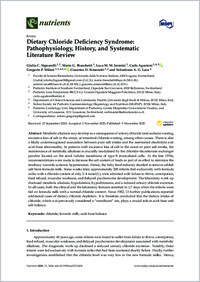Dietary chloride deficiency syndrome : pathophysiology, history, and systematic literature review
- Signorelli, Giulia C. Faculty of Biomedical Sciences, Università della Svizzera italiana, Switzerland - Pediatric Institute of Southern Switzerland, Ospedale San Giovanni, Bellinzona, Switzerland
- Bianchetti, Mario G. Faculty of Biomedical Sciences, Università della Svizzera italiana, Switzerland
- Jermini, Luca M. M. Faculty of Biomedical Sciences, Università della Svizzera italiana, Switzerland
- Agostoni, Carlo Pediatric Unit, Fondazione IRCCS Ca’ Granda Ospedale Maggiore Policlinico, Milan, Italy - Department of Clinical Sciences and Community Health, Università degli Studi di Milano, Italy - Italian Society for Pediatric Gastroenterology Hepatology and Nutrition (SIGENP), Milan, Italy
- Milani, Gregorio P. Pediatric Institute of Southern Switzerland, Ospedale San Giovanni, Bellinzona, Switzerland - Pediatric Unit, Fondazione IRCCS Ca’ Granda Ospedale Maggiore Policlinico, Milan, Italy - Department of Clinical Sciences and Community Health, Università degli Studi di Milano, Italy - Italian Society for Pediatric Gastroenterology Hepatology and Nutrition (SIGENP), Milan, Italy
- Simonetti, Giacomo D. Faculty of Biomedical Sciences, Università della Svizzera italiana, Switzerland - Pediatric Institute of Southern Switzerland, Ospedale San Giovanni, Bellinzona, Switzerland
- Lava, Sebastiano A. G. Pediatric Cardiology Unit, Department of Pediatrics, Centre Hospitalier Universitaire Vaudois, and University of Lausanne, Switzerland
-
09.11.2020
Published in:
- Nutrients. - 2020, vol. 12, no. 11, p. 10 p
English
Metabolic alkalosis may develop as a consequence of urinary chloride (and sodium) wasting, excessive loss of salt in the sweat, or intestinal chloride wasting, among other causes. There is also a likely underrecognized association between poor salt intake and the mentioned electrolyte and acid–base abnormality. In patients with excessive loss of salt in the sweat or poor salt intake, the maintenance of metabolic alkalosis is crucially modulated by the chloride–bicarbonate exchanger pendrin located on the renal tubular membrane of type B intercalated cells. In the late 1970s, recommendations were made to decrease the salt content of foods as part of an effort to minimize the tendency towards systemic hypertension. Hence, the baby food industry decided to remove added salt from formula milk. Some weeks later, approximately 200 infants (fed exclusively with formula milks with a chloride content of only 2–4 mmol/L), were admitted with failure to thrive, constipation, food refusal, muscular weakness, and delayed psychomotor development. The laboratory work-up disclosed metabolic alkalosis, hypokalemia, hypochloremia, and a reduced urinary chloride excretion. In all cases, both the clinical and the laboratory features remitted in ≤7 days when the infants were fed on formula milk with a normal chloride content. Since 1982, 13 further publications reported additional cases of dietary chloride depletion. It is therefore concluded that the dietary intake of chloride, which was previously considered a “mendicant” ion, plays a crucial role in acid–base and salt balance.
- Language
-
- English
- Classification
- Pathology, clinical medicine
- License
- Open access status
- gold
- Identifiers
-
- RERO DOC 333616
- DOI 10.3390/nu12113436
- ARK ark:/12658/srd1319355
- Persistent URL
- https://n2t.net/ark:/12658/srd1319355
Statistics
Document views: 217
File downloads:
- Fulltext: 221
